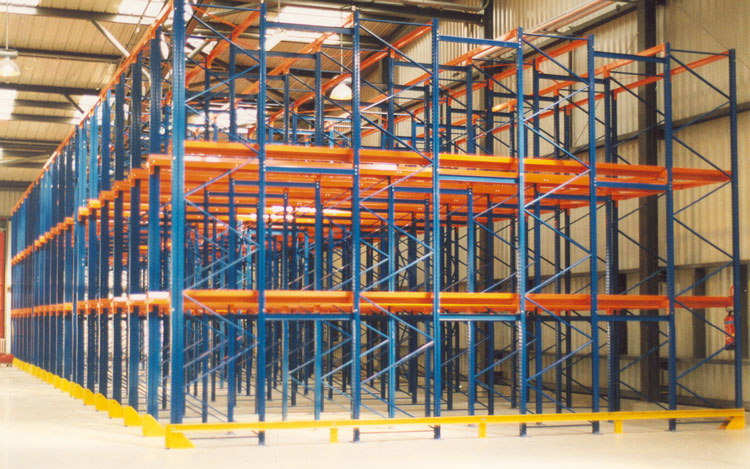When using drive-in pallet racking in cold-storage environments, several specific safety considerations come into play:
Forklift Safety
✅ Reduced Visibility:
Cold storage facilities often have issues with fogging due to the temperature difference between the inside and outside. This can significantly reduce the visibility of forklift operators. To address this, forklifts should be equipped with enhanced lighting systems, such as bright LED headlights and additional work lights. The lights should be regularly maintained and checked to ensure they are functioning properly.
✅ Slippery Floors:
Condensation in cold storage can lead to icy or slippery floors. Forklift operators need to be especially cautious and operate at reduced speeds. Anti-slip tires can be used on forklifts to improve traction. Additionally, the floor should be regularly de-iced and kept clean to minimize the risk of slips and falls.
✅ Equipment Performance:
Cold temperatures can affect the performance of forklifts. For example, the battery life of electric forklifts can be significantly reduced. It’s essential to have a proper battery-charging schedule and ensure that the forklift batteries are in good condition. For internal – combustion – engine – powered forklifts, cold starts can be more difficult, and the engine may need to warm up for a longer period. Operators should be trained to handle these situations and be aware of any changes in the forklift’s handling characteristics in the cold.
Rack Structure Safety
✅ Corrosion and Rust:
The cold and often humid environment in cold storage can cause corrosion and rust on the drive-in pallet racking. Regular inspections should focus on checking for signs of rust, especially on the joints, bolts, and other metal – to – metal contact points. Using corrosion-resistant coatings and materials during the installation of the racking can help prevent rust. If rust is detected, it should be treated promptly to avoid weakening the structure.
✅ Thermal Expansion and Contraction:
The metal components of the racking can expand and contract due to temperature changes. This can lead to loosening of bolts and connections over time. During installation and regular maintenance, it’s important to ensure that all connections are properly tightened and that any movement of the racking due to temperature changes is accounted for. For example, using spring-loaded fasteners or expansion joints in appropriate locations can help accommodate these changes.
Product Handling and Storage
✅ FIFO/LIFO Considerations:
As mentioned earlier, drive-in pallet racking typically operates on a last-in, first-out (LIFO) basis. In a cold-storage environment, this may not be suitable for all products. For perishable goods that need to be stored and retrieved on a first-in, first-out (FIFO) basis, special inventory management procedures need to be implemented. This could involve careful labeling and tracking of pallet entry and exit times to ensure that products with earlier expiration dates are used first.
✅ Falling Objects:
In cold storage, products can sometimes freeze together or become brittle. When forklifts are handling pallets, there is a risk of products falling from the pallets. Workers should wear appropriate personal protective equipment (PPE), such as hard hats, to protect against falling objects. Additionally, pallets should be properly loaded and secured to minimize the risk of product spillage.
Worker Safety and Comfort
✅ Cold – Stress Hazards:
Workers in cold-storage environments are at risk of cold stress, including hypothermia and frostbite. Adequate cold-weather clothing, such as insulated coveralls, gloves, and boots, should be provided to all employees. Additionally, work schedules should be designed to limit the amount of time workers spend in the cold environment to prevent overexposure.
✅ Emergency Preparedness:
In case of an emergency, such as a forklift breakdown or a worker injury, it’s crucial to have a well-planned emergency response procedure. Emergency exits should be clearly marked and kept clear of obstructions. Communication systems, such as intercoms or radios, should be reliable and accessible to all workers to ensure that help can be summoned quickly.
Post time: Apr-28-2025

